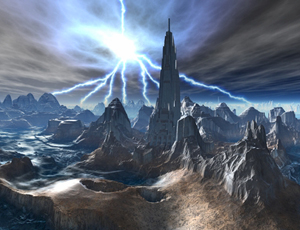
Scooter and I found three boots. We found them under a broken slab of fallen ceiling in what should have been the main galley. Whatever had become of the rest of the Wave One colonists, no one knew. That is what the troops of the Delta recon unit had traveled light-years to find out.
 We came prepared. All-terrain exploration suits for our team. Enough soldiers on ship to reinforce this position if Scooter and I found the colonists had encountered unexpected resistance from others in this system. Our sick bay carried 19 stasis-pods to medevac the men and women of Wave One if the science team had missed a pathogen in the initial decontamination sweep—not that it looked like anything could live in this hell. Our engineers had stocked replacement comm units if the radio silence turned out to be as simple as a few fried wires.
We came prepared. All-terrain exploration suits for our team. Enough soldiers on ship to reinforce this position if Scooter and I found the colonists had encountered unexpected resistance from others in this system. Our sick bay carried 19 stasis-pods to medevac the men and women of Wave One if the science team had missed a pathogen in the initial decontamination sweep—not that it looked like anything could live in this hell. Our engineers had stocked replacement comm units if the radio silence turned out to be as simple as a few fried wires.
I scanned the area while Scooter searched near the boots. Even as he dug, the wind carried more red sand into the area he was excavating. It didn't look like we would need any of those preparations now. The only job left for us was to discover why this was not the bustling outpost it was meant to be. This might be one for the history books, I thought, recalling the class on colonization at the academy. It's the mysteries and the failures that people remember.
![]() Scooter growled as he uncovered a fourth boot. I knew he wasn't going to find what he was looking for. No organic material could survive once it was exposed to this heat and atmosphere. Our troops were forever lost in this dust bowl. Still, it was impossible to ignore that there should have been two of our people here, right on this spot, for us to bring home.
Scooter growled as he uncovered a fourth boot. I knew he wasn't going to find what he was looking for. No organic material could survive once it was exposed to this heat and atmosphere. Our troops were forever lost in this dust bowl. Still, it was impossible to ignore that there should have been two of our people here, right on this spot, for us to bring home.
"There's nothing!" Scooter snarled. He bagged the boots, while I scanned for clues. I took in the collection of half-height walls and the mounds that grew behind them as sand fell in the wind-sheltered space the barriers created.
The remains of the colony looked like the ruins of an ancient civilization. The only difference was the construction printer, erect and untouched, above it all. This model was built to withstand any environmental hazards faced by our colony site. Its alloy supports shined in the harsh light from this planet's sun. The hydrochloric rain and the constant wind had buffed its metal clean, but the structures the printer constructed had not faired as well. These walls clearly had no protective sealant layer, and they would not stand long in these conditions without it. With one hand I touched the wall core nearest me and felt it give as if it were foam beneath the pressure of my expedition suit. I traced the word "Croatoan" onto the crumbling structure's surface and grimaced.
My launcher weapon pulled heavily on my belt. It was useless in this ghost town.
At least I knew our footwear was quality.
"Let's keep moving," I said. Scooter and I continued walking along the remains of the galley wall. My boot landed on another fallen slab of wall, and I felt it crunch as if it were ice-crusted snow. Near the printer supply unit, we found a stack of untouched sealant cartridges. To save themselves, the colonists only needed to insert these cartridges into the printer, and the sealant would have been mixed and laid on the wall cores as they were erected. But the team hadn't done so! Instead, they must have huddled in the galley and listened to the acid rains beat down on the unprotected roof.
It was inconceivable they so passively accepted their doom.
Again, my eyes found the printer unit standing proud above the ruins. It blazed white in the autumn sun. The troops would have done everything they could to get the sealant applied. I knew who the traitor was, but I had to check.
I found the control panel on the back of the unit. The hinges on the cover didn't even squeak when I opened it. I stared. "Printer error," blinked the pristine information screen. "Wrong model cartridge. Printer error."

Eva Sawyer is a PhD candidate in neurosciences at Vanderbilt University. She is interested in the evolution of sensory systems and currently investigating the sense of touch and, specifically, how the brain map of an animal's skin surface changes between species with different body forms. Sawyer values science fiction because good stories can communicate the wonder of science. This story is her first to be based more on construction than on biological principles, though it was inspired by her time working in the lab: No number of PhDs, MacArthur geniuses or National Academy of Science members can keep the lab printer working.
To see all of the Construction Science Fiction stories, click here.


Post a comment to this article
Report Abusive Comment